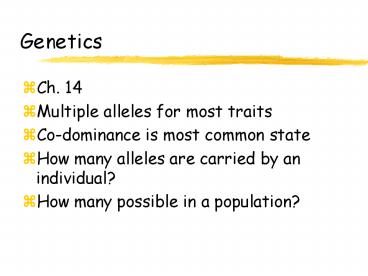Genetics - PowerPoint PPT Presentation
1 / 29
Title:
Genetics
Description:
Steps in Evolution. Mutation gives rise to genetic variation. ... Flower Evolution ... Flower Evolution. The plant evolved mouse-attractive flowers to protect ... – PowerPoint PPT presentation
Number of Views:104
Avg rating:3.0/5.0
Title: Genetics
1
Genetics
- Ch. 14
- Multiple alleles for most traits
- Co-dominance is most common state
- How many alleles are carried by an individual?
- How many possible in a population?
2
- Ch. 16, pages 266 - 271
- Ch. 17, pages 281 - 288
3
Review
- How are traits passed on to the next generation?
Where does the variation in traits come from?
Why is variation important?
4
Evolution
- How would you define it?
What evidence is there that evolution occurs?
What is the mechanism of this change?
5
Natural Selection as a Mechanism
- Charles Darwin - 1844
- Alfred Russell Wallace - 1858
6
- On the Origin of Species by Means of Natural
Selection or the Preservation of Favoured Races
in the Struggle for Life.
7
Darwins Mechanism
- 1. Each species produces more offspring than
survive.
8
Darwins Mechanism
- 2. There is variation within the offspring.
9
Darwins Mechanism
- 3. The offspring are in competition for limited
resources.
10
Darwins Mechanism
- 4. The best competitors survive to reproduce.
They are the most fit.
11
Darwins Fate
12
Key Terms
- Gene Pool
- All the various alleles for all traits of a
population.
- Population
- All the individuals in one area at one time of
one species
13
Key Terms
- Fitness
- the ability of an organism to survive and
reproduce in its environment
- Adaptation
- an inherited trait that leads to fitness
How does an adaptation arise in a population?
14
Steps in Evolution
- Mutation gives rise to genetic variation.
- Genetic variation results in differential
adaptedness.
- Differential adaptedness results in differential
reproduction.
- More individuals in population express the
inherited characteristic.
15
Evolutionthe change in allele frequency in a
population over time
16
Lecture Activity
- What are the steps that led to the evolution of a
flower that is mouse pollinated from one usually
pollinated by a bird? - Step One - a mutation(s) arise(s) in an
individual resulting in variation. - You complete the list of steps.
17
- Does selection occur on the genotype or the
phenotype?
What does that imply about the fate of recessive
alleles?
18
Evolution
- Genetic variation arises by chance.
- Evolution is not directed from within organism.
Those not fit for the present environment do not
reproduce as much as those that are fit.
- Alleles for successful traits increase.
19
Flower Evolution
- Plant would be better adapted if it changed
pollinators, so gradually the plants acquire a
yeasty-scented, brown flower close to the ground.
Plants in each generation became more yeasty,
brown and close to the ground than their parents
did.
20
Flower Evolution
- Because the environment of the plants ancestors
favored more mice than birds, mutant individuals
arose that had more mouse-attractive flowers.
Selection favored these individuals, and
eventually all of them had mouse-attractive
flowers.
21
Flower Evolution
- The existence of strategies as complex as
mouse-attractive flowers cannot be explained by
traditional evolutionary theory because
structures like these are too complex to arise by
chance.
22
Flower Evolution
- Because the ancestors of these plants needed to
change pollinators, nature allowed them to
develop the ability to produce mouse-attractive
flowers.
23
Flower Evolution
- The plant evolved mouse-attractive flowers to
protect attract a new pollinator.
24
Hardy-Weinberg Law (No evolution)
- 1. No mutations.
- 2. Mating is random. No sex selection.
- 3. No gene flow (no migration).
- 4. No selection.
- 5. No genetic drift.
- large population unaffected by chance changes (a
reduction) in allele frequency
25
Genetic Drift
- Chance events that reduce allele frequency in a
population
- Natural disasters (bottleneck effect)
- Beginning a new population (founder effect)
- Greater effect on small populations
26
Speciation
- Biological Species Concept- all individuals that
share many characteristics and are able to breed
with each other sharing a gene pool.
27
Speciation
- 1. Temporal
- 2. Geographic
- 3. Mechanical
- 4. Gametic incompatibility
- 5. Behavioral (Does not apply to plants.)
- 6. Strategy change
28
(No Transcript)
29
Artificial Selection
- Brassica oleracea
- Cabbage
- Broccoli
- Cauliflower
- Brussels Sprouts
- Kohlrabi































